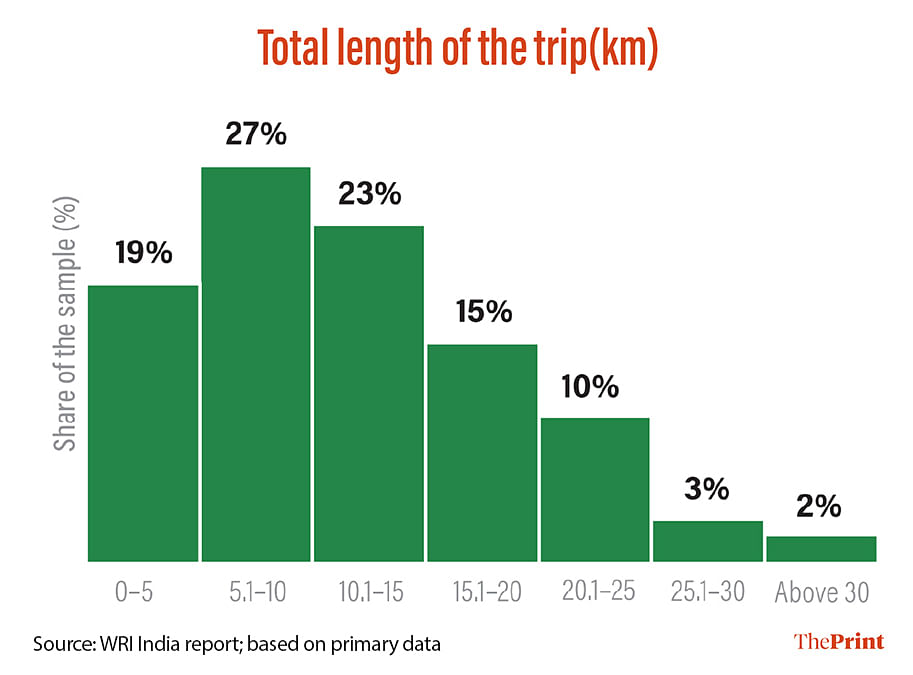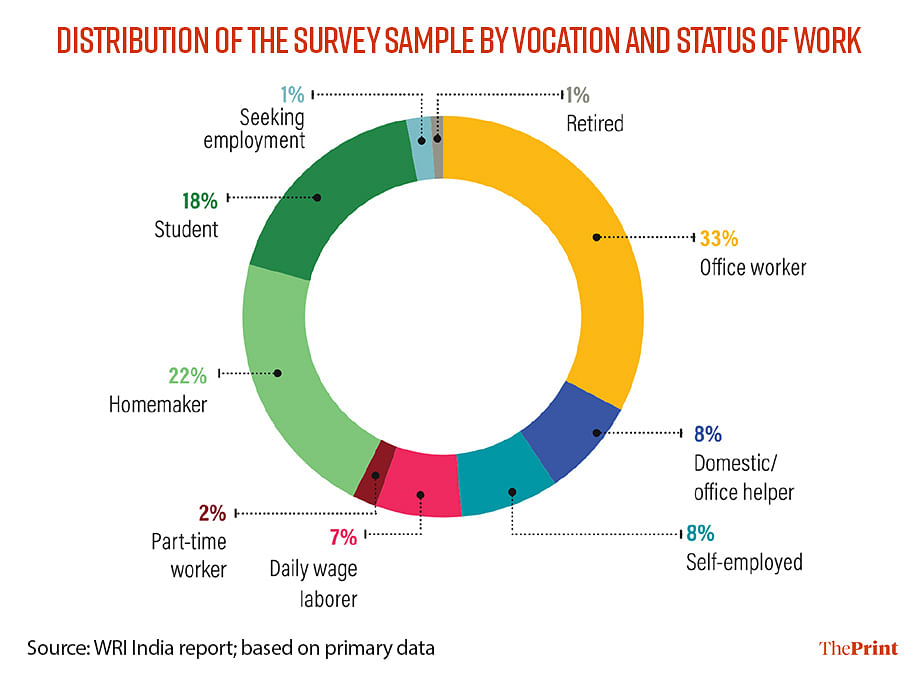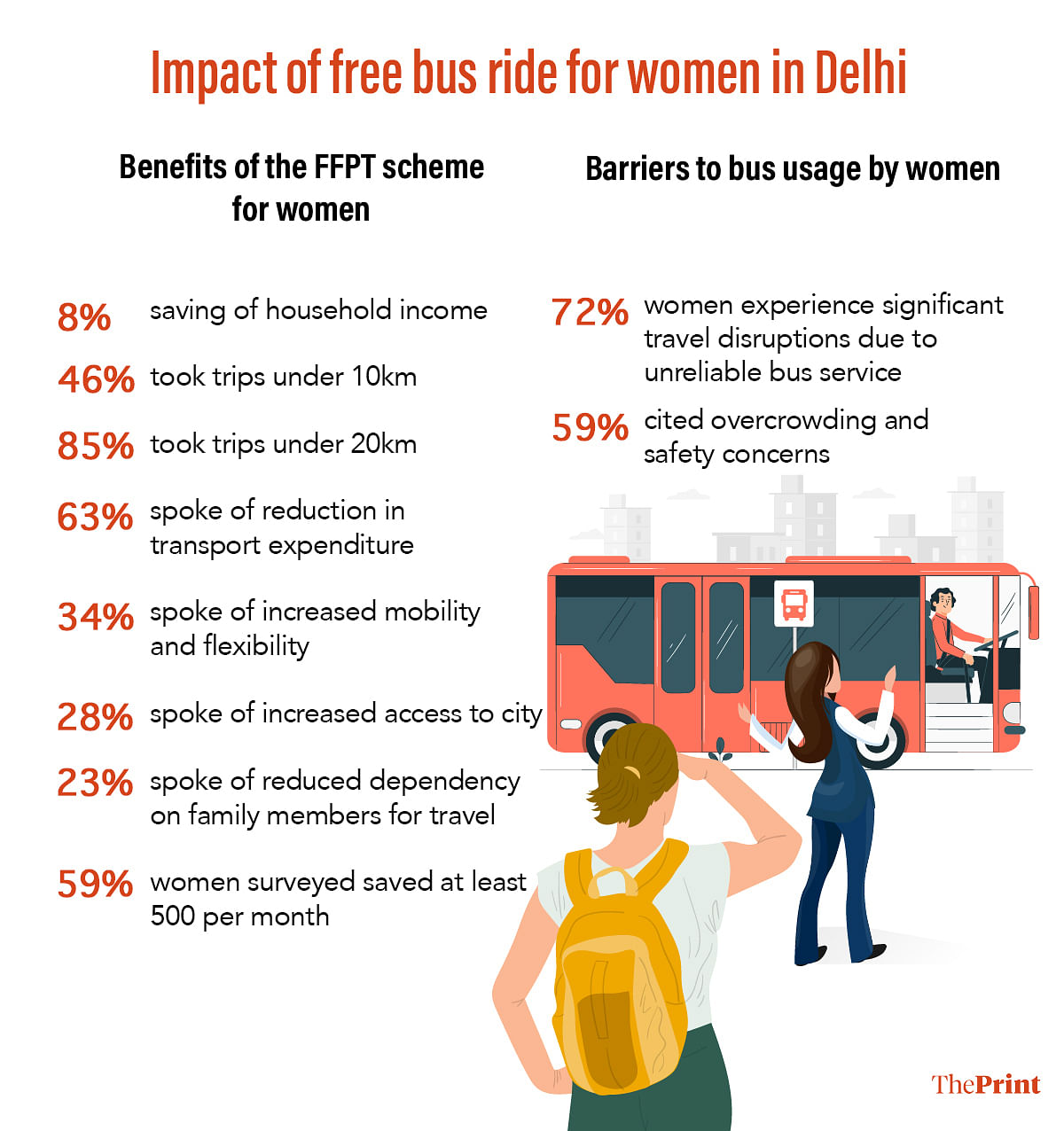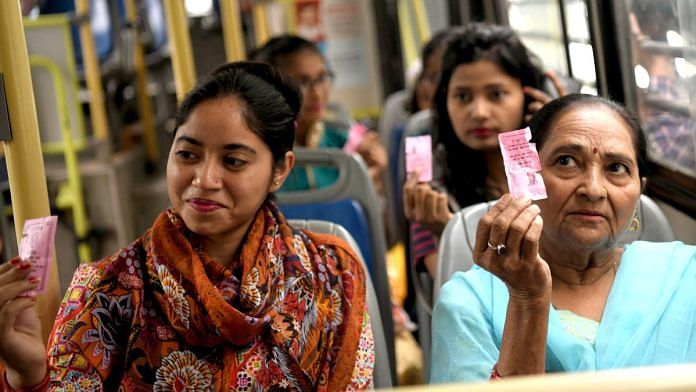New Delhi: The scheme making bus rides free for women in the Capital helped them save up to 8 percent of their monthly household income, improved access to better education and employment opportunities, and reduced their dependence on family members for commuting, according to a working paper by the World Resources Institute (WRI), India.
“Over 90 percent of these women (mostly from economically weaker sections) use buses on a weekly basis for work, education, caregiving, and discretionary activities. As many as 95 percent of the women in our sample lack access to a private vehicle and rely on buses due to economic constraints. They reported that the FFPT (fare-free public transport) scheme saved up to 8 percent of their household income per month,” it said.
Released Thursday, the paper titled ‘Fare-free bus travel scheme for women: Lessons from Delhi’ highlighted that the scheme, primarily benefitting women from lower income groups, helped women save between Rs 500 and Rs 2,300 on monthly transport expenses.
As many as 59 percent of respondents said they saved at least Rs 500 per month.

For this study, authors recorded the responses of 2,010 women bus users in different parts of Delhi. Nearly 58 percent of the respondents were workers, another 22 percent were homemakers and 18 percent were college students among others (retired and those seeking employment). Nearly 28 percent belonged to the Economically Weaker Sections.
Further, the working paper stated that nearly 90 percent of the women surveyed, mostly from lower income families, took the bus for work, education or caregiving purposes, with one in two women availing of this scheme to travel to a destination under 10 km.

The FFPT scheme allowing women to travel fare-free in all AC and non-AC buses in Delhi was introduced by the then Arvind Kejriwal-led Aam Aadmi Party (AAP) government in October 2019. While Delhi was the first in the country to introduce this scheme, it has since turned into a staple poll promise, and found mention across election manifestos in Karnataka, Punjab, Tamil Nadu, Telangana, and Andhra Pradesh, among other states.
In Delhi, the scheme led to a surge in women’s share in total bus ridership—from 33 percent in 2019 to 42 percent in 2023, the paper found, attributing it to a large number of women shifting to buses from other modes of transport such as metro and auto-rickshaw.
Chaitanya Kanuri, associate director (Electric Mobility) at WRI India and one of the three co-authors of the working paper, told ThePrint Thursday, “Half of the respondents reported monthly savings of Rs 500–1,000 on bus fares, while those who previously relied on shared transport modes such as auto-rickshaws or the metro experienced even greater savings of Rs 1,700 (metro users) to 2,300 (auto-rickshaw users) per month.”
Basing their calculation on the number of tickets sold each day by the Delhi Transport Corporation (DTC) and Delhi Integrated Multi-Modal Transit System (DIMTS), which operates the cluster bus service, the authors estimated that the scheme helps women taking the bus in Delhi save “a total of INR 19.6 million every day”.
“Female bus ridership is up. DTC and DIMTS data from May of 2023 indicate that over 21 million pink tickets were issued daily. We estimate that that this number has risen to over a half million, and that women traveling on buses in Delhi are now saving a total of INR 19.6 million every day,” the working paper said.
Also Read: Buses are key to fuelling Indian women’s economic success. Here’s why
‘Enabled women to use buses for short trips’
Nearly 63 percent of respondents said the scheme reduced the amount they spent on commuting, which forms a major part of household expenditure.
Before the scheme was introduced, the paper found, travel expenditure constituted 8 percent of the monthly household income for women from Economically Weaker Sections (EWS), 4 percent for women from Low Income Group (LIG), and 2 percent for women from Middle Income Group (MIG). A large number of women make multiple short trips for work or personal reasons, including dropping kids to school or caring for the elderly.
“Given this demographic profile, the fare-free public transport scheme plays a crucial role in benefiting women commuters. It also enabled them to use buses for short trips, which they might have avoided earlier due to Delhi’s telescopic fare structure, where per-kilometre costs are higher for shorter distances and lower for longer ones,” said Kanuri, who co-authored the paper along with Harshita Jamba and Aravinda Devaraj from WRI India.

Further, the paper said that, besides helping with monthly household savings, the scheme also opened up new economic and education-related avenues for women, as they could now easily cover long distances. After the introduction of the scheme, the paper found, “The share of women making shorter trips (under 4 km) by bus has increased by 12 percent and of those traveling 4–10 km has increased by 15 percent.”
Referring to the time before the introduction of the scheme in October 2019, the paper said women commuters in Delhi had to travel 7.92 km on average by bus. Only about 18 percent of Delhi’s formal job opportunities were accessible to them within this distance, it added. “After the introduction of the scheme, their average travel distance has increased to 10.52 km, allowing them to access 33 percent of the city’s formal job opportunities.”

The paper added that about 34 percent of respondents said the scheme improved their mobility since they were able to make multiple and frequent trips for various purposes.
About 23 percent of respondents said it reduced their dependence on family members, since it allowed them to travel alone. Further, around 20 percent of the respondents said the scheme enabled them to travel farther than they could earlier.
Discrimination & safety: major challenge
On challenges they faced, respondents identified overcrowding, besides discriminatory attitude and poor monitoring of movement of buses.
According to the paper, 54 percent of respondents reported enduring snide remarks and/or discriminatory attitudes, from both the bus crew and fellow male passengers.
“These remarks, often centered around the use of pink tickets, characterize women as taking advantage of the system rather than legitimately utilising the services designed for them,” the paper said.

Approximately 20 percent of the respondents said drivers often stop buses far from designated stops, particularly during peak hours, amid heavy traffic, or in isolated areas with few women around.
Many also called attention to how the buses are seldom on time or the frequency is low.
In the paper, the authors recommended improving the overall quality of bus services, sensitising the staff. They also stressed on the need to collect gender-disaggregated mobility data for monitoring and evaluation.
(Edited by Amrtansh Arora)
Also Read: ‘The road is mine and I am flying’—but men waiting for DTC women bus drivers to fail







Please stop this nonsense. In telangana, congress govt started free bus scheme for woman. There may be some genuine beneficiaries, but mostly this scheme is misused. Everywhere, we see crowded buses. Those people who were using public buses before are going for expensive options. Struggles of men are countless. Bus corporation is slowly reaching its death. Government can not able to replace old buses and introduce new busesdue to lack of additional revenue. Women are themselves saying they are not happy with the scheme. In sum, it is a totally Tuglaq scheme.